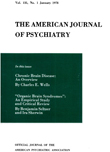THE ROLE OF THE FATHER IN FAMILIES WITH A SCHIZOPHRENIC PATIENT
Abstract
A small number of fathers, mothers, and their schizophrenic children have been studied as a group and treated in family psychotherapy for periods up to 2½ years. The view of the family as a single organism provides a broader, more distant perspective than is possible with close up views of individual family members. An effort is made to avoid the use of terms and descriptions that are associated with the more familiar individual perspective.
The father is described as he is seen to function in terms of the broader family perspective. Several prominent patterns have emerged when the family has been viewed from this position. The family members, particularly the father and mother, function in reciprocal relation to each other. They are separated from each other by an emotional barrier which, in some ways, has characteristics of an "emotional divorce." Either father or mother can have a close emotional relationship with the patient when the other parent permits. The patient's function is similar to that of an unsuccessful mediator of the emotional differences between the parents. The most frequent family pattern is an intense two-some between mother and patient which excludes the father and from which he permits himself to be excluded. The family pattern changes under varying individual and family circumstances in the course of daily living.
Access content
To read the fulltext, please use one of the options below to sign in or purchase access.- Personal login
- Institutional Login
- Sign in via OpenAthens
- Register for access
-
Please login/register if you wish to pair your device and check access availability.
Not a subscriber?
PsychiatryOnline subscription options offer access to the DSM-5 library, books, journals, CME, and patient resources. This all-in-one virtual library provides psychiatrists and mental health professionals with key resources for diagnosis, treatment, research, and professional development.
Need more help? PsychiatryOnline Customer Service may be reached by emailing [email protected] or by calling 800-368-5777 (in the U.S.) or 703-907-7322 (outside the U.S.).



